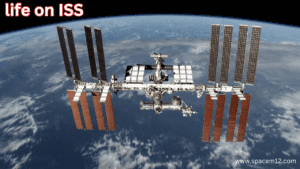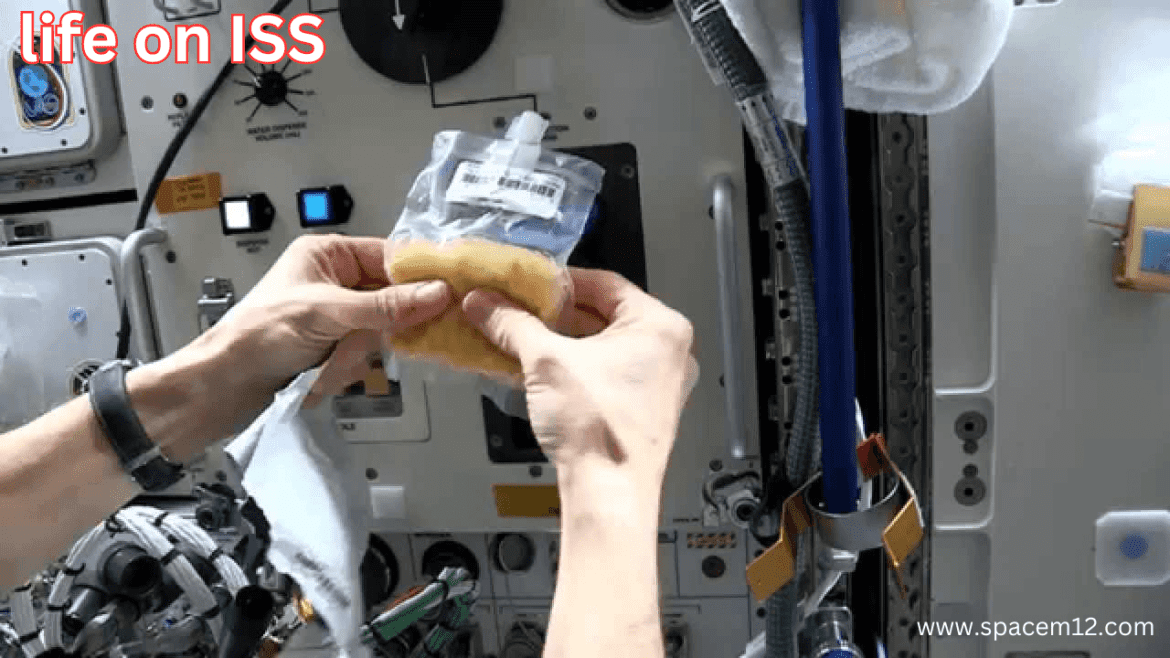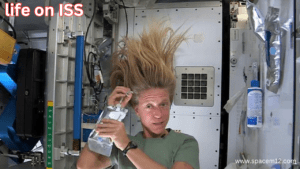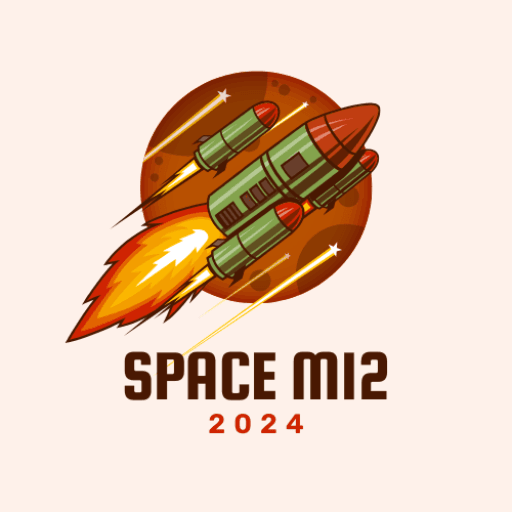Introduction
Life on (ISS) presents unique challenges and experiences for astronauts. Their daily routine on ISS involves a carefully structured schedule, balancing living conditions, exercise routines, and science experiments. From sleeping on ISS in weightless environments to managing hygiene and cooking in space, astronauts adapt to microgravity. Maintaining health on ISS is crucial, as they perform various crew tasks to support ongoing missions and advance space exploration.
Daily Life on the ISS
Life aboard the International Space Station (ISS) is a unique blend of routine and adaptation to a zero-gravity environment. Astronauts follow a structured schedule to balance work, exercise, and leisure while navigating the challenges of microgravity. Here’s a closer look at daily life on the ISS:
1. Living Conditions
- Zero-Gravity Adaptations: Every aspect of life, from sleeping to eating, is affected by microgravity. Astronauts sleep in tethered sleeping bags to prevent floating and use Velcro straps to secure items.
- Personal Space: Each astronaut has a small crew quarters for rest, communication with family, and personal time.
- Food and Meals: Food is prepared to prevent crumbs, and drinks come in sealed pouches. Astronauts use utensils adapted for space to eat safely.
2. Work Schedule
- Scientific Research: A significant part of the day is dedicated to conducting experiments across biology, physics, and materials science. These studies benefit life on Earth and future missions.
- Maintenance and Operations: Crew members ensure the station runs smoothly by repairing systems and updating equipment.
- Communication with Earth: Regular check-ins with mission control keep operations coordinated.
3. Physical Health and Exercise
- Daily Workouts: Astronauts exercise for about two hours daily using resistance machines and stationary bicycles to counteract muscle and bone loss in microgravity.
- Health Monitoring: Regular medical check-ups ensure astronauts remain healthy during their missions.
4. Recreation and Leisure
- Leisure Activities: Astronauts spend free time reading, watching movies, or connecting with family. Observing Earth from the Cupola is a favorite pastime.
- Team Bonding: Crew members often share meals or play games to build camaraderie.
5. Hygiene and Sanitation
- Hygiene Routines: Showers are replaced by no-rinse wipes, and toothpaste is swallowable. Astronauts use vacuum-powered toilets designed for microgravity.
- Resource Management: Water is carefully conserved and recycled to ensure a sustainable supply.
6. Unique Challenges
- Adjusting to the absence of gravity requires creative problem-solving and mental resilience. The routine also includes learning to work efficiently in confined spaces with an international team.
Daily life on the ISS exemplifies human adaptability, teamwork, and the innovative spirit needed to live and thrive in space.
Health and Hygiene
Maintaining health and hygiene on the International Space Station (ISS) is essential for the well-being of astronauts during their extended missions. The unique microgravity environment requires innovative solutions and strict routines to ensure optimal health and cleanliness.
1. Physical Health
- Impact of Microgravity:
- Muscle and bone loss are significant concerns due to the lack of gravitational forces.
- Cardiovascular changes, including fluid shifts that cause “moon face” swelling, are monitored closely.
- Exercise Routines:
- Astronauts work out for about two hours daily using specialized equipment like resistance bands and treadmills with harnesses.
- Regular exercise helps maintain muscle strength and bone density.
- Medical Monitoring:
- Routine health checks are conducted, including blood tests, vision screenings, and assessments of overall physical condition.
- A medical kit is on board to handle minor ailments or injuries.
2. Hygiene in Microgravity
- Bathing and Personal Care:
- Without flowing water, astronauts use no-rinse wipes and waterless shampoo for cleaning.
- Small amounts of water are used sparingly and carefully to avoid free-floating droplets.
- Oral Hygiene:
- Toothpaste is specially designed to be swallowable, and astronauts brush their teeth similarly to on Earth.
- Clothing and Laundry:
- Clothes are not washed but replaced periodically. Used garments are disposed of in departing cargo vehicles.
3. Sanitation Systems
- Waste Management:
- Toilets on the ISS use vacuum suction to collect and manage human waste. Liquid waste is recycled into potable water.
- Water Recycling:
- The Environmental Control and Life Support System (ECLSS) processes and recycles water from sweat, urine, and cabin humidity.
- This closed-loop system ensures a sustainable water supply.
4. Psychological Well-Being
- Maintaining mental health is critical, as stress, isolation, and the confined environment can affect mood and performance.
- Regular communication with loved ones and access to recreational activities support emotional health.
Science and Research
The International Space Station (ISS) serves as a world-class laboratory, conducting experiments that advance our understanding of science, technology, and space exploration. The microgravity environment allows for unique research opportunities that are not possible on Earth.
1. Unique Research Environment
- Microgravity: Provides a setting to study phenomena like fluid dynamics, combustion, and crystal growth without the interference of gravity.
- Global Collaboration: Scientists from around the world use the ISS to conduct experiments, fostering international partnerships in science and technology.
2. Key Areas of Research
- Biology and Life Sciences:
- Studying how microgravity affects human cells, tissues, and the immune system.
- Researching plant growth in space to support future missions and sustainable agriculture on Earth.
- Physical Sciences:
- Investigating materials and fluid behaviors in zero gravity.
- Experiments on fire safety in space, combustion processes, and material stability.
- Earth and Space Observation:
- Monitoring climate change, weather patterns, and natural disasters.
- Studying cosmic rays, dark matter, and the physics of the universe.
3. Advancing Space Exploration
- Health Studies:
- Research on bone density loss, muscle atrophy, and vision changes informs the health management of astronauts on long-duration missions.
- Testing Technologies:
- Evaluating life support systems, radiation shielding, and space robotics for future missions to the Moon, Mars, and beyond.
- Behavioral Studies:
- Studying the psychological effects of isolation and confinement on astronauts.
4. Contributions to Earth
- Medical Advancements:
- Insights into osteoporosis, cardiovascular health, and cancer research are applied to treatments on Earth.
- Technological Innovations:
- Development of more efficient water recycling and renewable energy technologies.
- Environmental Monitoring:
- Enhanced understanding of Earth’s ecosystems, enabling better conservation strategies.
5. Future Implications
- The ISS continues to prepare humanity for deeper space exploration.
- Lessons learned and technologies developed will be integral to establishing a sustainable human presence beyond Earth.
Psychological Aspects of Life on the ISS
Living aboard the International Space Station (ISS) presents unique psychological challenges due to isolation, confinement, and microgravity. Astronauts must adapt mentally and emotionally to maintain their well-being and mission effectiveness in such an extreme environment.
1. Isolation and Confinement
- Physical and Social Isolation:
- Astronauts are separated from family, friends, and Earthly comforts for extended periods.
- The small crew size and limited physical space can intensify feelings of loneliness.
- Coping Mechanisms:
- Regular video calls and emails with loved ones help maintain emotional connections.
- Crew bonding activities, such as shared meals and celebrations, foster camaraderie.
2. Stress and Mental Health
- Stressors:
- High workloads, time pressure, and technical challenges can contribute to stress.
- The ever-present risk of emergencies, like equipment failures or space debris, adds to the mental load.
- Stress Management:
- Structured schedules provide predictability and reduce decision fatigue.
- Access to mental health resources, such as private consultations with psychologists, is critical.
3. Impact of Microgravity
- Sensory Changes:
- The absence of gravity affects spatial orientation, potentially causing disorientation or discomfort.
- Adaptation:
- Most astronauts adapt quickly to microgravity, but it requires mental resilience during the initial adjustment period.
4. Team Dynamics
- Interpersonal Relationships:
- Close quarters and diverse cultural backgrounds can lead to conflicts if not managed effectively.
- Effective communication, mutual respect, and teamwork are essential for a harmonious crew.
- Leadership and Support:
- Strong leadership helps maintain morale and resolve disputes.
- Peer support among crewmates is vital for emotional well-being.
5. Countermeasures for Psychological Health
- Training:
- Pre-mission psychological training helps astronauts prepare for the mental demands of spaceflight.
- Recreation:
- Activities like watching movies, reading, and observing Earth from the Cupola provide relaxation and mental stimulation.
- Routine and Autonomy:
- Daily routines balance structured work with personal time, offering astronauts a sense of control.
Challenges of Living on the ISS
Life aboard the International Space Station (ISS) is both remarkable and demanding. While astronauts experience incredible scientific opportunities and stunning views of Earth, they also face numerous challenges due to the station’s unique environment. These challenges require adaptability, innovation, and rigorous training.
1. Physical Challenges
- Microgravity Effects:
- Prolonged exposure leads to muscle atrophy, bone density loss, and fluid redistribution, causing “puffy face” syndrome.
- Altered cardiovascular function and vision problems, known as Spaceflight-Associated Neuro-Ocular Syndrome (SANS), are common.
- Radiation Exposure:
- Astronauts face increased risks of radiation from cosmic rays and solar flares, which can affect long-term health.
- Sleep Disruption:
- The 90-minute orbit cycle disrupts circadian rhythms, making restful sleep difficult.
2. Technical and Operational Challenges
- Maintenance and Repairs:
- Constant upkeep is required to maintain critical systems like air recycling, water purification, and temperature control.
- Spacewalks to repair external components are physically taxing and carry risks.
- Resource Limitations:
- Supplies like food, water, and spare parts are limited and require careful management.
- Recycling systems for air and water must function flawlessly to sustain the crew.
3. Psychological Challenges
- Isolation and Confinement:
- Separation from family, confined living spaces, and limited social interaction can lead to feelings of loneliness or stress.
- Team Dynamics:
- Cultural differences and prolonged close quarters can strain interpersonal relationships if not effectively managed.
- Mental Fatigue:
- The high-pressure environment and demanding schedules can contribute to cognitive and emotional exhaustion.
4. Environmental Challenges
- Temperature Extremes:
- The ISS experiences rapid shifts between extreme heat and cold as it orbits Earth.
- Systems must regulate internal temperatures to ensure astronaut comfort and equipment functionality.
- Space Debris:
- Micrometeoroids and orbital debris pose constant threats, requiring the ISS to perform evasive maneuvers to avoid collisions.
5. Adapting to Microgravity
- Everyday tasks, like eating, sleeping, and hygiene, require adjustments and creative solutions.
- Tools and procedures must be designed to prevent items from floating away or causing accidents.
Future of Living in Space
The future of living in space holds immense potential for both scientific advancements and human exploration. As technology and research continue to evolve, human presence beyond Earth is becoming increasingly feasible, with the International Space Station (ISS) providing invaluable insights into long-term space habitation.
1. Advancements in Space Habitation
- Lunar Bases:
- NASA’s Artemis program aims to return humans to the Moon by the mid-2020s, with plans for a sustainable base on the lunar surface.
- The Moon could serve as a testing ground for technologies and systems needed for longer missions, such as Mars.
- Mars Colonization:
- Private companies like SpaceX are working toward making human settlement on Mars a reality, with the goal of establishing a self-sustaining colony by the 2030s.
- Challenges such as radiation protection, food production, and psychological well-being are being researched to ensure long-term survivability.
- Space Stations Beyond Earth Orbit:
- Concepts for future space habitats, such as O’Neill cylinders or inflatable habitats, aim to provide more space and comfort than the ISS, supporting deeper space missions.
2. Technological Innovations for Space Living
- Life Support Systems:
- Advances in closed-loop life support systems, such as water and air recycling technologies, will allow humans to live in space for extended periods without resupply from Earth.
- Sustainable Energy:
- Solar power will continue to be the main energy source, but new technologies like nuclear power may be explored for deeper space missions.
- Artificial Gravity:
- Research is underway into creating artificial gravity using rotation-based systems to mitigate the health risks associated with long-term exposure to microgravity.
3. Psychological and Social Adaptations
- Isolation and Mental Health:
- As missions become longer, developing robust mental health strategies will be essential. Telemedicine, virtual reality, and regular communication with Earth will be key to maintaining morale and mental health.
- Social Dynamics:
- Crew members will have to adapt to living in close quarters for long durations. Crew composition will be diverse, requiring strong interpersonal skills and conflict management.
- Autonomy and Decision-Making:
- Space habitats will require astronauts to be self-sufficient, able to perform maintenance and solve problems without constant communication with mission control.
4. Commercial Space Living
- Space Tourism:
- Companies like Blue Origin and Virgin Galactic are pioneering space tourism, offering brief trips to low Earth orbit. As technology matures, the cost of these trips will decrease, making space tourism more accessible to the public.
- Private Space Stations:
- Businesses are exploring the development of commercial space stations, where scientists, tourists, and industry professionals could live and work in space for extended periods.
- Space Mining:
- The extraction of resources from asteroids or the Moon may help support future space colonies, providing materials for construction and fuel.
5. The Role of the ISS in Shaping the Future
- The ISS continues to provide critical data on living and working in space, including the effects of microgravity on the human body, the long-term sustainability of space habitats, and the performance of advanced life support systems.
- Innovations developed on the ISS will directly inform future missions to the Moon, Mars, and beyond, making the ISS a cornerstone of human space exploration.

life on ISS
FAQS
1. What does a day in life look like on the ISS?
Life in the ISS means living in a microgravity environment where astronauts do science, exercise, and conduct all aspects of life in a confined space. In many ways it is quite different from Earth with objects floating around them and very little personal space.
2. How do astronauts train on the ISS?
Astronauts also maintain an exercise regimen using highly specialized equipment-treadmills, stationary bicycles, and resistance machines. Exercise is a must to avoid the deterioration of muscles and bones in space due to no gravity.
3. An astronaut eats what when living on the ISS?
The astronauts consume pre-prepared space food, which can be lightweight, nutritious, and shelf-stable. Meals come in vacuum-sealed containers or pouches, and most often they need to be rehydrated with water.
4. How do astronauts cope with the solitude on ISS?
Astronauts stay in touch with their family and friends through video calls and sending emails, besides keeping themselves busy by playing games and maintaining a daily routine for combating isolation.
5. What are the effects of microgravity on human bodies?
Physical alterations include muscle wasting, bone mineral loss, fluid shift, and changes in vision. The astronauts are regularly checked up with the medical provider to evaluate this effects and assess their health.
6. What types of experiments are conducted on the ISS?
The ISS serves as a laboratory for many different scientific investigations in the areas of biology, physics, material science, and Earth observation. The investigation, which cannot be approached from Earth, yields a bit of information obtained from microgravity.
7. How do astronauts regulate their exposure to radiation on the ISS?
Partial protection is offered by the space station to the radiation; however, astronauts are still exposed to higher levels as compared to the Earth’s surface. They track the level of radiation and take safety measures not to expose themselves too much in case of solar storms.
8. What is the routine of the astronauts on the ISS for a day?
The working hours for the astronaut on the ISS, usually, have hours spent working on the experiment, exercising, eating, and free time. Such a routine promotes mental health and productivity.
9. Can astronauts see Earth from the ISS?
Well, yes! For scientists, the astronauts have large windows aboard the ISS with great views of Earth. Often, astronauts take photos of the planet’s landscapes, weather patterns, or city lights.
10. How long does an astronaut spend on the ISS?
Missions on the ISS typically last six months to a year, but some astronauts spent an extended period in space for their research project.

life on ISS
Conclusion
The ISS has revolutionized space exploration, offering insights into human adaptability in space and the long-term impacts of missions. Its research contributes to science and humanity, preparing for future space habitation. Lessons learned and experiments conducted on the ISS highlight its significance, ensuring the future of life on ISS supports pioneering advancements.





1 comment
Creative genius! AI Hug shows how AI can create magic.